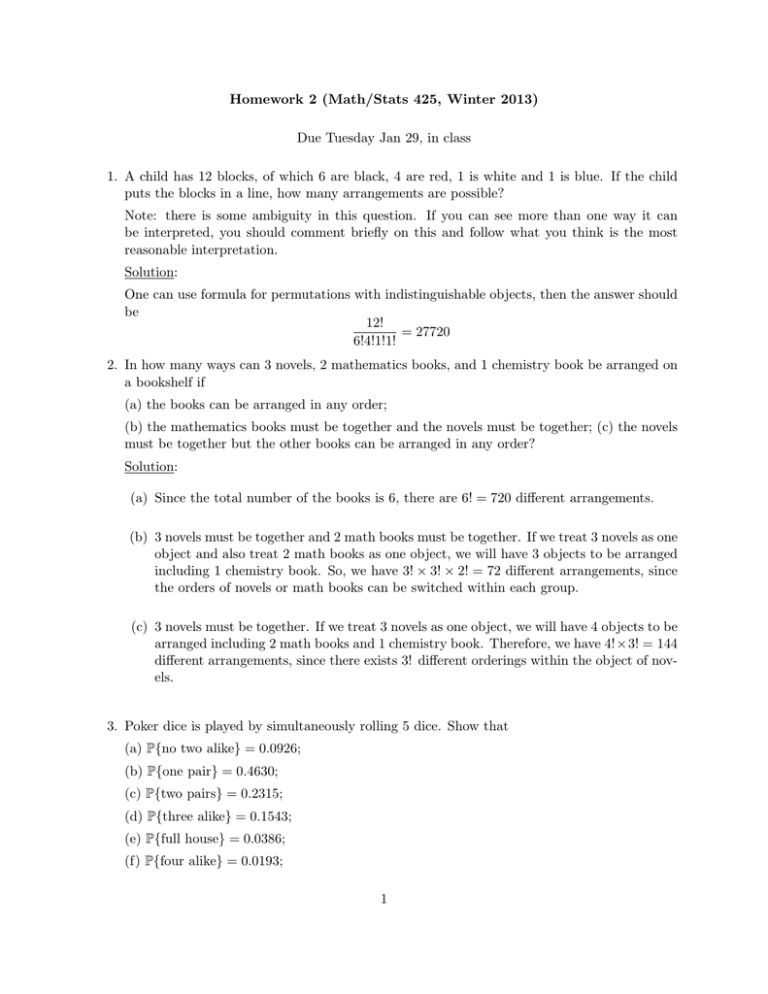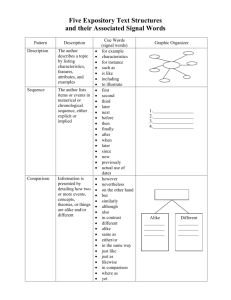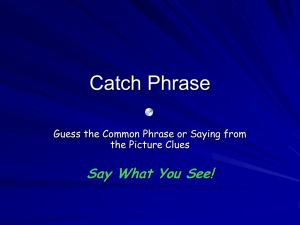Homework 2 (Math/Stats 425, Winter 2013) Due Tuesday Jan 29, in
advertisement

Homework 2 (Math/Stats 425, Winter 2013)
Due Tuesday Jan 29, in class
1. A child has 12 blocks, of which 6 are black, 4 are red, 1 is white and 1 is blue. If the child
puts the blocks in a line, how many arrangements are possible?
Note: there is some ambiguity in this question. If you can see more than one way it can
be interpreted, you should comment briefly on this and follow what you think is the most
reasonable interpretation.
Solution:
One can use formula for permutations with indistinguishable objects, then the answer should
be
12!
= 27720
6!4!1!1!
2. In how many ways can 3 novels, 2 mathematics books, and 1 chemistry book be arranged on
a bookshelf if
(a) the books can be arranged in any order;
(b) the mathematics books must be together and the novels must be together; (c) the novels
must be together but the other books can be arranged in any order?
Solution:
(a) Since the total number of the books is 6, there are 6! = 720 different arrangements.
(b) 3 novels must be together and 2 math books must be together. If we treat 3 novels as one
object and also treat 2 math books as one object, we will have 3 objects to be arranged
including 1 chemistry book. So, we have 3! × 3! × 2! = 72 different arrangements, since
the orders of novels or math books can be switched within each group.
(c) 3 novels must be together. If we treat 3 novels as one object, we will have 4 objects to be
arranged including 2 math books and 1 chemistry book. Therefore, we have 4!×3! = 144
different arrangements, since there exists 3! different orderings within the object of novels.
3. Poker dice is played by simultaneously rolling 5 dice. Show that
(a) P{no two alike} = 0.0926;
(b) P{one pair} = 0.4630;
(c) P{two pairs} = 0.2315;
(d) P{three alike} = 0.1543;
(e) P{full house} = 0.0386;
(f) P{four alike} = 0.0193;
1
(g) P{five alike} = 0.0008;
Note: a full house is three of a kind together with a pair.
Solution:
Rolling 5 dice. The number of total events will be 65 .
6
(a) We want to get 5 different numbers from 5 dice. Since there are
ways to
5
choose 5 different numbers
from 1 to 6, and 5! different orderings for each of 5 dice,
6
#(no two alike) =
× 5! = 720. Therefore, the probability P (no two alike) =
5
720
= .0926
65
(b) We can first choose which
number
will
be a pair (from 1 to 6), and which dice
will
be
6
5
5
a pair. So, there are
×
ways to choose a pair. And there are
× 3!
1
2
3
6
possible different choices for the dice which is not a pair. So, #(one pair) =
×
1
5
5
× 3! = 3600. And, therefore the probability P (one pair) = 3600
×
= .4630.
65
3
2
(c) We can first choose which two numbers will be pairs, and which dice will be pairs,
and
6
×
then can choose one remaining number from 4 choices. So, #(two pairs) =
2
4
3
5
= 1800 Therefore, the probability P (two pairs) = 1800
×
×
= .2315.
65
1
2
2
(d) First we can choose which number will be the common number, and which dice will
have the common number,
and then can choose
two remaining numbers from 5 choices.
5
5
6
× 2! = 1200 Therefore, the probability
×
×
So, #(three alike) =
2
3
1
P (three alike) = 1200
= .1543.
65
5
5
6
= 300 Therefore, the probability
×
×
(e) Similarly, #(f ull house) =
1
3
1
P (f ull house) = 300
= .0386.
65
6
5
5
(f) Similarly, #(f our alike) =
×
×
= 150 Therefore, the probability
1
4
1
P (f our alike) = 150
= .0193.
65
(g) Sincewe can choose which number will be the overall common number, #(f ive alike) =
6
= 6 Therefore, the probability P (f ivealike) = 665 = .0008.
1
4. A forest contains 20 elk, of which 5 are captured, tagged and then released. A certain time
later 4 of the elk are captured. What is the probability that exactly 2 of these 4 have been
tagged? Comment briefly on the assumptions you are making and their reasonableness (this
kind of capture-recapture study, together with the assumptions required to do a probabilistic
analysis of the data, is a fundamental procedure for ecological studies).
2
Solution:
20
5
15
The number of total events is
. And there are
×
different ways to choose
4
2
2
2 from the previously tagged elks, and 2 from the elks which have not
beentagged
before.
5
15
×
2
2
.
Therefore, the probability P (2 of 4 captured elks have been tagged) =
20
4
To get this answer, we are assuming that each elk is equally likely to be chosen, and no
elk was born or dead between the two capture points.
5. Five people, designated A, B, C, D, E, are arranged in a line. Assuming that each order is
equally likely, find the chance that
(a) there is exactly one person between A and B;
(b) there are exactly two people between A and B;
(c) there are three people between A and B.
Solution:
(a) If A is first, then A can be in any one of 3 places and B’s place is determined, and the
others can be arranged in any of 3! ways. As a similar result is true, when B is first, we
see that the probability in this case is 2 × 3 × 3!/5! = 3/10
(b) Similarly, this time if A is first, A can just have 2 choices. So the final answer is
2 × 2 × 3!/5! = 2/10
(c) 2 × 1 × 3!/5! = 1/10
6. Given 20 people, what is the probability that among the 12 months of the year there are 4
months containing exactly 2 birthdays and 4 months containing exactly 3 birthdays? Comment briefly on your assumptions.
Solution:
20
One person’s
birthday
canbe in one of the 12 months, so the number of total events is 12 .
12
8
There are
×
ways to choose 4 months containing 2 birthdays and 4 containing
4
4
3 birthdays. Then
divide
20
people as 8 groups of (2, 2, 2, 2, 3, 3, 3, 3).
12
8
(20)!
Probability=
/1220
4
4 (3!)4 (2!)4
3


